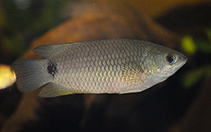| Family: |
Anabantidae (Climbing gouramies) |
| Max. size: |
17.4 cm TL (male/unsexed); 13.46 cm SL (female) |
| Environment: |
benthopelagic; freshwater, potamodromous |
| Distribution: |
Africa: Senegal and Gambia rivers, entire Niger River drainage except lower Niger, Lake Chad drainage and coastal drainages in Côte d’Ivoire, Ghana, Togo and Benin (Ref. 57414). Also reported from Gabon (Ref. 6803) and Nile basin (Ref. 6803, 28714). |
| Diagnosis: |
Dorsal spines (total): 16-19; Dorsal soft rays (total): 9-12; Anal spines: 8-10; Anal soft rays: 9-12; Vertebrae: 25-27. Diagnosis: snout blunt; jaws weakly protrusible (ascending process of premaxilla short, not reaching anterior border of orbit); labyrinth composed of a more complex, folded plate; adults larger than 75 mm SL; body depth into SL usually fewer than 3 times; spot at base of caudal fin without pale ring in adults; lachrymal never serrated; flanks without faint mottling; scales in lower vertical series 10-11 (rarely 9); 5 scales from last pored scale in upper lateral line to dorsal-fin base (counting pored scale)(Ref. 57414).
Description: 13-17 pored scales in upper lateral line; 9-14 pored scales in lower lateral line (Ref. 57414, 93191). Interorbit 2.4-3.0 times into head length; 12-21 scales on right operculum (Ref. 93191). 3-5 scales above upper lateral line; 8-10 scales below upper lateral line (Ref. 57414, 93191). Operculum and suboperculum well serrated; interoperculum and preoperculum sometimes serrated (Ref. 57414).
Coloration: body, head and unpaired fins medium to light grey or brown, with belly usually lighter; dark caudal spot (ocellated in juveniles) well developed; pectoral and pelvic fins unpigmented; body in juvenile specimens (25 mm SL) chocolate brown with some tan mottling and a narrow, pale bar at level of dorsal-fin origin; Loiselle (1971) reported that living animals from Togo were olive-coloured with red irises (Ref. 57414). |
| Biology: |
Inhabits marginal vegetation, swamps, and floodplains. Browses on plant tissues with ostracods, dipteran larvae, beetles, mollusks and debris (Ref. 28714). |
| IUCN Red List Status: |
Least Concern (LC); Date assessed: 18 December 2019 Ref. (130435)
|
| Threat to humans: |
harmless |
Source and more info: www.fishbase.org. For personal, classroom, and other internal use only. Not for publication.

